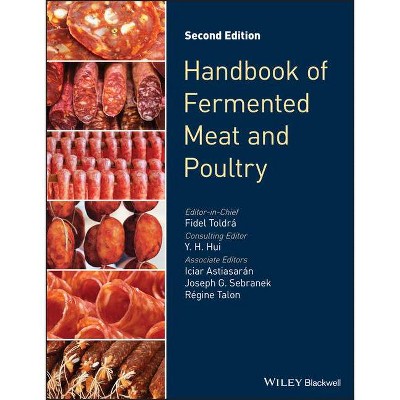Handbook of Fermented Meat and Poultry - 2nd Edition by Fidel Toldrá (Hardcover)

Product info
<p/><br></br><p><b> About the Book </b></p></br></br>-Covers the whole manufacturing process from raw materials and starter cultures through to finished product quality assurance---<p/><br></br><p><b> Book Synopsis </b></p></br></br><p>Fermented meat products have been consumed for centuries in many different parts of the world and constitute one of the most important groups of food. Bacterial cultures are used in their manufacture to preserve the meat and confer particular textures and sensory attributes. Examples of fermented meats include salami, chorizo, pepperoni and saucisson.</p> <p>This fully revised and expanded reference book on meat fermentation presents all the principle fermented meat products and the processing technologies currently used in their manufacture. The 54 chapters of this substantial book are grouped into the following sections: </p> <ul> <li>Meat fermentation worldwide: overview, production and principles</li> <li>Raw materials</li> <li>Microbiology and starter cultures for meat fermentation</li> <li>Sensory attributes</li> <li>Product categories: general considerations</li> <li>Semidry-fermented sausages</li> <li>Dry-fermented sausages</li> <li>Other fermented meats and poultry</li> <li>Ripened meat products</li> <li>Biological and chemical safety of fermented meat products</li> <li>Processing sanitation and quality assurance</li> </ul> <p>There are five new chapters in the second edition that address the following topics: Smoking and new smoke flavourings; Probiotics; Methodologies for the study of the microbial ecology in fermented sausages; Low sodium in meat products; and Asian sausages.</p> <p><i>Handbook of Fermented Meat and Poultry, Second Edition</i> provides readers with a full overview of meat fermentation, the role of microorganisms naturally present and/or added as starter cultures, safety aspects and an account of the main chemical, biochemical, physical and microbiological changes that occur in processing and how they affect final quality. Finally, readers will find the main types of worldwide fermented meat products, typically produced in different areas, with the description of their main characteristics.</p><p/><br></br><p><b> From the Back Cover </b></p></br></br><p>Fermented meat products have been consumed for centuries in many different parts of the world. Today they constitute one of the most important groups of food worldwide. Bacterial cultures are used in their manufacture to preserve the meat and to confer particular textures and sensory attributes upon it. Examples of fermented meats include salami, chorizo, pepperoni, and saucisson. <p>This fully revised and expanded reference on meat fermentation presents the principle fermented meat products and the processing technologies currently used in their manufacture. The 54 chapters of this substantial book are grouped into the following sections: <ul> <li>Meat fermentation worldwide: overview, production, and principles</li> <li>Raw materials</li> <li>Microbiology and starter cultures</li> <li>Sensory attributes</li> <li>Product categories: general considerations</li> <li>Semidry-fermented sausages</li> <li>Dry-fermented sausages</li> <li>Fermented products from poultry and other meats</li> <li>Ripened meat products</li> <li>The biological and chemical safety of fermented meat products</li> <li>Processing sanitation and quality assurance</li> </ul> <p>There are five new chapters in the second edition, addressing the following topics: smoking and new smoke flavourings, probiotics, methodologies for the study of the microbial ecology in fermented sausages, low sodium in meat products, and Asian sausages. <p><i>Handbook of Fermented Meat and Poultry, Second Edition</i> provides readers with a full overview of meat fermentation, the role of microorganisms (both naturally present and added as starter cultures), safety aspects, and the main chemical, biochemical, physical, and microbiological changes that occur in processing and how they affect final quality. Readers will find descriptions of the main types of fermented meat product worldwide and their main characteristics.<p/><br></br><p><b> About the Author </b></p></br></br><p><b>Editor-in-Chief: </b><br> Dr Fidel Toldrá, Instituto de Agroquímica y Tecnología de Alimentos (CSIC), Paterna, Valencia, Spain <p><b>Consulting Editor: </b><br> Dr Y. H. Hui, Science Technology System, West Sacramento, CA, USA <p><b>Associate Editors: </b><br> Dr Iciar Astiasarán, Department of Food Science, Nutrition and Physiology, University of Navarra, Pamplona, Spain<br> Dr Joseph G. Sebranek, Food Science and Human Nutrition, Iowa State University, Ames, IA, USA<br> Dr Régine Talon, INRA, UR454 Microbiologie, Saint-Genès Champanelle, France
Price History
Price Archive shows prices from various stores, lets you see history and find the cheapest. There is no actual sale on the website. For all support, inquiry and suggestion messagescommunication@pricearchive.us